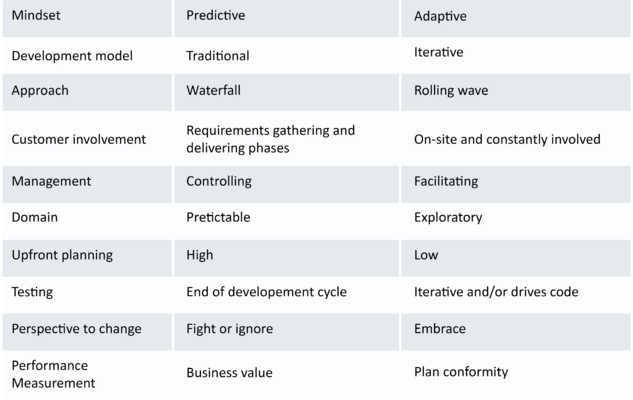The Rolling-wave Planning
Developed by Jiajing Zhang
Contents |
Abstract
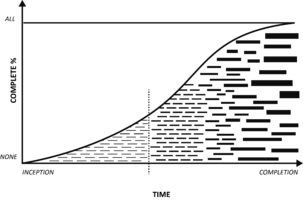
It is not often possible to foresee the future activities in a project with consistent detail throughout the entire duration of the project. One method for dealing with unexpected events in the distant future has been called rolling wave planning. When project managers recognize that firm commitments cannot be made on the basis of volatile information, they develop plans in waves as the project unfolds and information becomes more reliable. [2]This method develops the work packages in greater detail as the project progresses by using progressive elaboration.
When using rolling wave planning, it is necessary to provide key milestones and assumptions as they will help stakeholders see the reason for using this method and what to expect as the project progresses. Plans are also updated as threats and opportunities materialize. The risks, assumptions, and milestones identified initially also become more defined and reliable during the project. Compared to definable projects using traditional planning (also known as predictive planning), rolling wave planning is more suitable for the teams on the short-term goals, course-correcting as needed and is particularly useful in projects with high uncertainty. [3]
The article will introduce the definition of rolling wave planning and explain it by the Mountain Climber Analogy. By comparing the respective characteristics of rolling wave planning and predictive planning, the situations in which the two methods are applied are summarized. This article will also provide the guidelines for using this method and a brief overview of the literature and area where the rolling wave can be applied, along with its limitations.
Introduction
According to the PMBOK Guide, rolling wave planning is an iterative method in which the work to be accomplished in the near term is planned in detail, while the work in the future is planned at a higher level. [4] It is used when there is not enough clarity to plan in detail in the project. This lack of clarity could come from various factors, such as unexpected events, lack of knowledge, changes and crises. At the beginning of the project, it’s a good idea to have an understanding of the “big blocks” without detailing exactly the scope of the project and decomposing the near team deliverables into individual components at the greatest level of detail. [1] After the scheduled activities for the early phase are underway, the detailed planning for the next phase would commence and so forth.
Mountain Climber Analogy
It is common for project managers to be asked about the estimates of the duration and the cost of a project before having a fully understanding of the scope. This situation is related to the discussion of how this scenario develops, why this approach seldom works, and what can be done to structure a more realistic alternative. To address this issue, Knuston suggested considering an analogy called Mountain Climber. [5] First, suppose there is an expert mountain climber, ready to climb a mountain he had never seen before. The sponsors of the expedition ask him questions about time and resources and expect for some reasonable reasons. In this case, the rolling wave is a method that can both satisfy the sponsors and add a sense of integrity and credibility to the commitments. This method suggests that the project planning effort “rolls out” detailed plans for the foreseeable future and, reevaluates the completion dates and costs as the project evolves. [5] Even though the expert only has minimal knowledge at the beginning, he is capable of approximating the time and resources required and providing the sponsor with a detailed plan with his mountain climbing background and experience, combined with historic data gathered from previous cases. Thus he can provide the sponsor with an approximation of the requirements in time and resources to finish the total effort and a detailed schedule for the first phase. Now the benefits of Rolling Wave come into effect. Unknowns have been resolved and decisions have been made at each phase as the project proceeds. At each subsequent reevaluation, the projections of the final deadline and costs become more realistic. There will come a point when enough information is available and the scope is well-defined, making further reevaluations unnecessary. [5]
Characteristics of Rolling wave planning
- Progressive elaboration: The Rolling Wave involves progressive elaboration to add detail to the Work Breakdown Structure (WBS) on an ongoing basis. It is the process of breaking down the work breakdown structure into time intervals. For example, Phases 1-2 might be broken down fully in the WBS. Phases 3-6 might be outlined only to the level of subprojects. Then, while schedule activities for phase 1 are underway, the detailed planning for phase 3 would commence. As phase 2 is put in motion, planning for phase 4 would start and so forth. [6] At the end of each phase, the project manager will study the structure of the WBS and will expand it to include more details. It is particularly suitable for projects where the work involved in a phase is highly variable and depends on the result of the previous phase, such as projects that require prototypes.
- Shorten time: Rolling wave is a key idea in agile methods and adaptive planning.[7] It is commonly found in SCRUM and other agile project management methodologies. Similar to Agile, rolling wave planning encourages adaptability and is good for projects with changing scope. [3] This technique may also help shorten time to completion in 2 ways: 1) By making it possible for productive activities to begin without waiting for every detail of the project work to be determined in advance. 2) By eliminating downtime for additional planning in the middle of a project since planning is done continuously. [6]
Rolling Wave Planning vs. Predictive Planning
Projects can be ranged from definable projects to high-uncertainty projects. Each type of project has its own set of management challenges and development approach. Definable projects with predictive life cycles are characterized by clear procedures that have proved successful on similar projects in the past. The deliverable of this type of project has risks associated with meeting regulatory requirements and is more suitable for predictive planning to build in extra testing, documentation, and robust processes and procedures.[4] Predictive planning, also known as traditional project management, is linear where all the phases of a process occur in a sequence. The entire project is planned upfront without any scope for changing requirements and is highly controlled.[7]
While projects with high uncertainty can be new designs, problem-solving, and not-done-before work and have a lot of risks associated with stakeholder acceptance. This type of delivery may choose an adaptive approach like rolling wave planning. The adaptive approach is considered to be the more modern type of development strategy that encourages the continuous iteration of development and reevaluation for projects with high rates of change, complexity, and risk. Deliverable of this type of project may release a minimum viable product to get feedback before developing additional features and functions and then replan by using rolling wave planning.[4]
One of the big ideas of agile and iterative development is to adapt based on feedback, and this is not only with respect to requirements and design, but also the plan or schedule. Adaptive planning is a refinement of the well-known rolling wave planning concept—more on this later. In contrast, predictive planning implies there would be such an iteration-by-iteration plan to the project's end. In adaptive planning, there are milestones with dates, but the path of iterations to those milestones is left flexible or adaptive. And, the milestones themselves may change if in the best interest of the project. Predictive planning would go further than this, it would speculate a week-by-week or iteration-by-iteration schedule of the path to these milestones. However, this can result in plans changing almost continuously as early work changes the requirements for later work.[7]
Adaptive planning is closer to optimal in terms of working towards milestones; each step can be the most skillful we know how to plan regarding risk, productivity, and effectiveness because each planning step is taken with maximum—and fresh—information. In contrast, a predictive plan is suboptimal. In fact, it could be close to the worst or most risky possible path to the milestone goal because it is created with the least amount of information, speculating into the far future. Not only is predictive planning suboptimal with respect to effectiveness and risk, but it also doesn't account for opportunities. Adaptive plans embrace change and opportunity; predictive plans fight or ignore it. [7]
The project team's way of working and the project manager's style also vary significantly depending on the development approach. Predictive planning usually entails more emphasis on up-front planning, measurement, and control. On the other end of the spectrum, adaptive planning, especially when using rolling wave planning, requires more of a servant leadership style and may have self-managing project teams.[4]
Guidelines of Rolling Wave Planning
Rolling wave program management works exceedingly well because it encourages a strategic perspective while executing the day-to-day work.
Six steps of Rolling Wave
Projects using rolling wave planning proceeds iteratively. Initially, the projects establish a top-down structure and then fill out the work bottom-up within each defined phase. Figure 3 illustrates the six steps of the rolling wave approach to balancing top-down and bottom-up planning.[8]
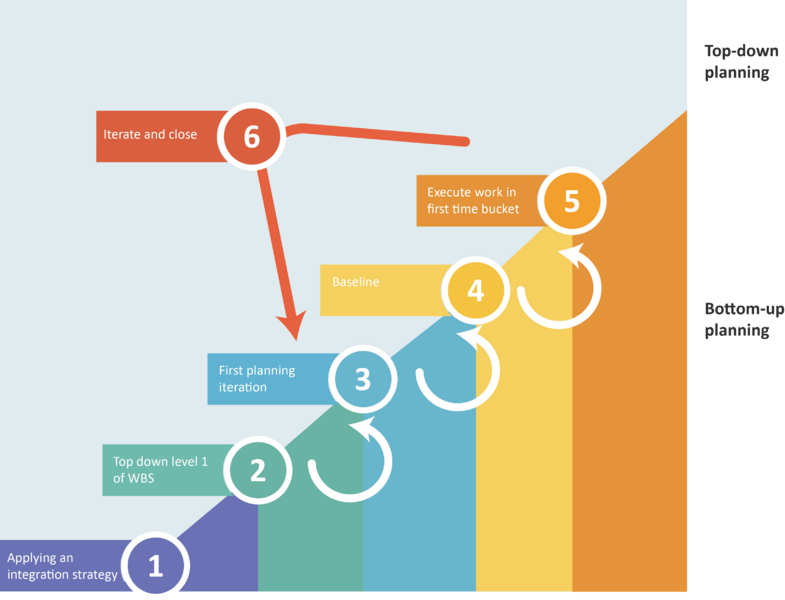
Step 1: Applying an Integration Strategy. The program manager takes the lead in establishing the theme of risk identification and mitigation plans. All development programs are fraught with unknowns and require dialogue among different people with different expertise. Three activities for readying the team for rolling wave are listed:
- First, evaluate the quality of the product vision and requirements.
- Second, define the initial product architecture and consider the design constraints and technical philosophies of the program.
- Third, align the program architecture with product architecture. Roles and responsibilities also need to be outlined for the team.
Step 2: Perform top-down planning from Level 1 of the WBS. Develop initial estimating approximations for time durations, resources, and expenses. Program management tools for describing the high-level perspective are familiar: organizational breakdown structure (OBS), work breakdown structure (WBS), product breakdown structure (PBS), and cost breakdown structure (CBS).
Step 3: Perform the first planning iteration and start bottom-up. IIn this step, the team adds details in individual work packages for the first wave (bottom-up). Timeline, budget and other necessary resources need to be tightened up for the next phase. Then, analyze the work with a network logic chart and publish it as a Gantt chart. The project manager should establish a work package and a fixed date for the next wave.
Step 4: Baseline. At this point, the program has identified two kinds of work: the work contained in not totally defined “black boxes” and the detailed work with time, cost and scope baselines.
Step 5: Execute the Planned Work in the First Time Bucket. Teams work on the plan while the project manager monitors and tracks their progress and performance. It is important to have a learning orientation for rolling wave planning so that teams can distill learning to react to risks or avoid future problems.
Step 6: Iterate and close the project. This last step involves the continuing iteration of the “plan a little, do a little” approach, ending with the closing of the program. The important elements include: Assess the team's learning, the needed work, and replan the next phase of the project (go back to Step 3). [8]
Application
When to apply the Rolling Wave Planning
Payne and Turner suggested different levels of planning according to project type and developed a project categorization system called the Goals and Methods Matrix described in Figure 4. Projects are categorized based on two variables:
- How well known the goals are
- How well known the methods are.
They found that for projects with unknown goals and unknown methods planning should have: a high-level project definition report, with the level of detail proportional to project size; a milestone plan and project responsibility chart, where milestones represent the lifecycle; lower-level detail developed use rolling wave planning. [9] For type 2 and type 3 projects, the lower level activity plans will be developed on a rolling-wave basis, as early components are delivered, or early life-cycle stages are completed respectively. [10]
Overall, this method can be applied when:
- It is not possible to define a detailed project plan shortly.
- It is not clear which deliverables should be produced.
- It is not possible to organize the different phases of the project.
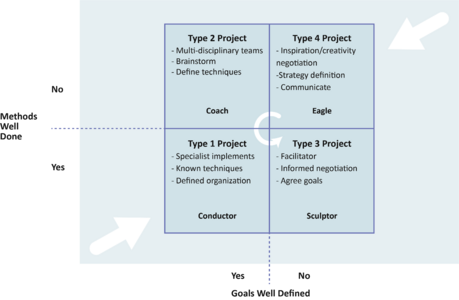
Rolling Wave Planning for dynamic environment
The business environment is changing at an increasing pace. Perrino and Tipping reported, "the pace of technology is accelerating, raising the stakes and risks for managing innovation, and requiring early warning and shorter response time". [11] Projects conducted in highly uncertain environments are a key unresolved project management issue and present the following challenges[12]:
- Planning for uncertain outcomes.
- Balancing flexibility with reliability and accountability.
- Balancing decision quality against decision speed.
- Timing scope freeze during rapid change.
In the dynamic environment, new events that compromised plans arose rapidly throughout project delivery. The quantity of change made detailed plans difficult to maintain. In the time it took to adjust the plan, additional changes would occur.
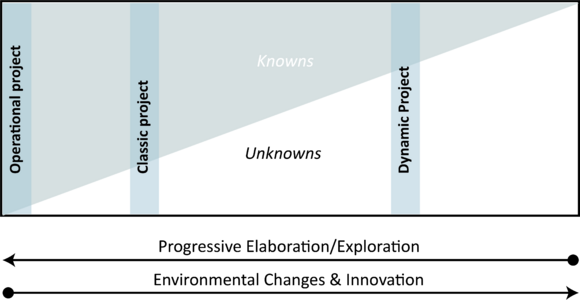
Analysis and decision-making had to be conducted more rapidly than the emergence of new changes. Plans with excessive detail were found to be misleading and abandoned in favor of rolling wave planning. Even in the static environment, there could be too many unknowns at the start to be resolved by the deadline, so the rapid introduction of new unknowns in the dynamic environment was doubly challenging. Using progressive elaboration to fulfill knowledge gaps, it might be possible to move a project to the left in Figure 5, thereby achieving the objective in a more predictable fashion.
Projects and Industries that good fit for Rolling Wave Planning
Rolling wave planning technique is suitable for projects where all the project planning data is not immediately available and when the project execution is risky. Generally, rolling wave planning is mostly used for software development. But there are other projects and industries that are a good fit for rolling wave planning and its iterative type of project planning. For example, research and development (R&D) projects are exploring and hoping to discover new products or services. These projects are not structured to finish with a knowable deliverable. [13]
Similarly, high-tech projects lend themselves to rolling wave planning. Program managers in new product development (NPD) and other technical environments face a number of challenges: information overload, numerous decisions, complexity, shifting strategies, unreliable suppliers, low participant commitment, management expectations for detailed control, the futility of scheduling inventions, speed and urgency, high uncertainty, finite market windows, and customer desires for flexibility. Some organizations approach these challenges by defining program management as “rules and tools” and end up rigid, bureaucratic, and ineffective at innovating. Other organizations become overwhelmed by the challenges, give up on processes, and rely on smart people to put forth their best efforts. [8]Any project that is devoted to innovation is going to constantly pivot to take advantage of opportunities. They are not on a linear path. They require the flexibility to respond as features change but still provide the control needed to deliver any project successfully.[13] As Kurian Jacob, a rolling-wave practitioner at Motorola, states: “We develop advanced technology capabilities that have never been done before. Rolling wave helps to meet the challenge of keeping energy focused on short-term work with the eye on the long term.”[8]
Limitations
Rolling wave planning is very helpful in projects with changing scope and high uncertainty. However, this method has its drawbacks and is not applicable in all cases. The four main limitations of rolling wave planning are listed below:
- Limited documentation: In rolling wave planning, documentation happens throughout a project, and often “just in time” for building the output, not at the beginning. As a result, it becomes less detailed and often falls to the back burner. [14]
- Scope creep: It is inevitable that the project scope will constantly expand due to the changing requirements from customers. Project management that is undertaken using rolling wave planning must have a well-defined project scope from the outset. Otherwise, as planning is elaborated scope creep is likely to occur. Teams may also become overwhelmed and lose track of these requirements, unsure of which ones to prioritize. [6]
- No finite end: The fact that rolling wave planning does not require detailed planning at the beginning makes it easy to get sidetracked delivering new, unexpected functionality. Additionally, it means that projects have no finite end, as there is never a clear vision of what the “final product” looks like. [14]
- Unsuitable for long-term projects: Finally, one of the most common problems in adaptive planning occurs when teams try to make the methodology work for unsuitable projects. Rolling wave planning is better at producing smaller deliverables incrementally, which is ideal for projects in a dynamic environment like R&D projects and software development. However, the iterative development model would not be compatible with a long-term project. Projects with fixed final deliverables and desirable changes are more suited to a waterfall framework.
Despite the benefits that Rolling wave planning can offer, it comes with some disadvantages that would derail a project and threaten its success. Therefore, it is important to use it where appropriate and be aware of these disadvantages before they escalate.
Annotated Bibliography
Rose, K. H. (2013). A guide to the project management body of knowledge (PMBOK Guide)—Fifth Edition. Project management journal, 3(44), e1-e1. [4]
The PMBOK Guide delivers a clear and concise explanation of rolling wave planning. It has also discussed the interactions between the development approach and life cycle performance domain and addressed the features of leadership and project teams when using adaptive planning and predictive planning.
Larman, Craig (2004). "Chapter 11: Practice Tips". Agile and Iterative Development: A Manager's Guide. p. 253. ISBN 9780131111554. Retrieved Oct 14, 2013. [7]
This book is the definitive guide for managers and students to agile and iterative development methods: what they are, how they work, how to implement them—and why you should. Chapter 11 gives a big idea of Rolling Wave Adaptive and discusses the topic of adaptive planning versus predictive planning. By comparing the two approaches, benefits of Rolling Wave Planning are demonstrated: response to uncertainties swiftly and ability to embrace change and opportunity.
Githens, G. D. (2001). Manage innovation programs with a rolling wave. PM Network, 15(5), 35–39. [8]
This article suggests using rolling wave planning to manage programs in new product development and other technical environments to resolve uncertainties and achieve faster results and outcomes that are more creative. It states that rolling wave planning can give a framework for creating a balanced program approach for control and flexibility. This article also provides very detailed guidelines for using this technique. It illustrates the six steps of the rolling wave approach to balancing top-down and bottom-up planning.
Payne, J. H., & Turner, J. R. (1999). Company-wide project management: the planning and control of programs of projects of different types. International journal of project management, 17(1), 55-59. [9]
This article gives an overview of different levels of planning according to project type, and developed a project categorization system called the Goals and Methods Matrix. It defines the scopes of projects that are suitable with rolling wave planning and suggests that for type 2 and type 3 projects, the lower-level activity plans will be developed on a rolling-wave basis.
References
- ↑ 1.0 1.1 Christian Thuesen (2022). Project management: Purpose.(How to scope a project) DTU ProjectLab. Reason for citation: One of the reasons for choosing the topic of rolling wave planning is that it is a concept that has been mentioned in APPPM as an effective method to uncertainty.
- ↑ Laufer, A., Hoffman, E. J., Russell, J. S., & Cameron, W. S. (2015). What successful project managers do. MIT Sloan Management Review, 56(3), 43.
- ↑ 3.0 3.1 Bright Hub PM. (2009, September 15). Rolling Wave Planning in Project Management. Brighthubpm.com. Retrieved from: https://www.brighthubpm.com/project-planning/48953-basics-of-rolling-wave-planning. Reason for citation: The founder of this site has extensive experience in project management and provides readers with the tutorials of usage and benefits of rolling wave planning./
- ↑ 4.0 4.1 4.2 4.3 4.4 4.5 Rose, K. H. (2013). A guide to the project management body of knowledge (PMBOK® Guide)—Fifth Edition. Project management journal, 3(44), e1-e1.
- ↑ 5.0 5.1 5.2 Knutson, J. (1996). Rolling wave approach to project management. PM Network, 10(6), 5, 8.
- ↑ 6.0 6.1 6.2 Tom Alby. Rolling Wave Planning. Project management knowledge.com Retrieved from: https://project-management-knowledge.com/definitions/r/rolling-wave-planning/Reason for citation: This website explains in a clear and concise manner how the project is iterative, which helps the reader to understand the meaning of Progressive elaboration/
- ↑ 7.0 7.1 7.2 7.3 7.4 7.5 Larman, Craig (2004). "Chapter 11: Practice Tips". Agile and Iterative Development: A Manager's Guide. p. 253. ISBN 9780131111554. Retrieved Oct 14, 2013.
- ↑ 8.0 8.1 8.2 8.3 8.4 8.5 Githens, G. D. (2001). Manage innovation programs with a rolling wave. PM Network, 15(5), 35–39.
- ↑ 9.0 9.1 Payne, J. H., & Turner, J. R. (1999). Company-wide project management: the planning and control of programs of projects of different types. International journal of project management, 17(1), 55-59.
- ↑ 10.0 10.1 Turner, J. R., Turner, J. R., & Turner, T. (1999). The handbook of project-based management: improving the processes for achieving strategic objectives.
- ↑ Perrino, A. C., & Tipping, J. W. (1991). Global management of technology: A study of 16 multinationals in the USA Europe and Japan: Practitioners' forum. Technology Analysis & Strategic Management, 3(1), 87-98.
- ↑ 12.0 12.1 Larson, E. W., Gray, C. F., & Desai, G. V. (2011). Project management: The managerial process.
- ↑ 13.0 13.1 Ryan Buma. (2021, October 28). What is Rolling Wave Planning? Project manager.com Retrieved from: https://www.projectmanager.com/blog/rolling-wave-planning. Reason for citation: This website summarises the companies that are suitable for rolling wave planning.
- ↑ 14.0 14.1 Rachaene Lynn. Disadvantages of Agile. Planview.com Retrieved from: https://www.planview.com/resources/articles/disadvantages-agile. Reason for citation: This site specializes in Agile Program Management and summarises for the reader the disadvantages to be aware of when using adaptive planning.
